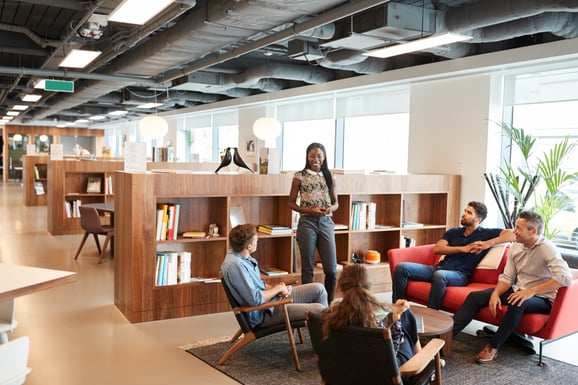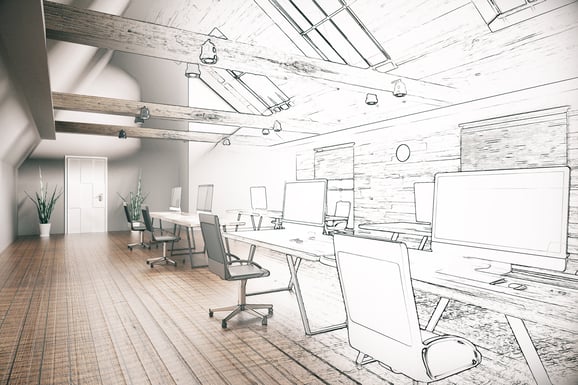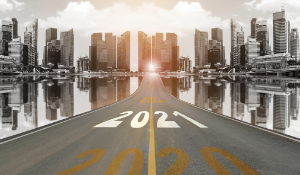The COVID-19 pandemic is changing many aspects of life as we once knew it. People living in cities who have relied on public transportation are purchasing cars in record numbers, calling into question transportation plans that reduce dependency on personal vehicles. Many of our nation’s children are learning online, forcing educators and parents to master virtual platforms. Telecommuting has become mainstream, resulting in a transformation of the way work is done. These profound shifts have underscored the need for flexible and adaptable planning so we can best respond to changing influences.
Today we are surrounded by incredible examples of resilience. Restaurants are using pods to accommodate outdoor diners in winter weather. Adaptive reuse principles are being applied to convert sports arenas into vaccine distribution centers, parking lots into farmers’ markets, and schools into meal distribution sites.
The workplace also needs to be flexible and resilient as organizations pivot to a new normal. The pandemic has presented a unique opportunity to reimagine the traditional workplace as an adaptable space that is responsive to unpredictable demands. While we don’t have a crystal ball to see into the future and we can’t guard the workplace against all threats, we must embrace a balanced approach and invest in a workplace that builds resilience and adaptability.
Certainly, the pandemic has accelerated a wide range of flexible workplace trends. Many of us are asking ourselves what the workplace will look like and how work will be performed once the pandemic is behind us. Although the rise in telework during the pandemic has decreased the dependence on physical office space, it’s not likely that the office will become completely obsolete. But is clear that the workplace of the future needs to be reimagined. Read on for a discussion of how your organization can be prepared for future challenges that may lie ahead.
Adopt a Hybrid Office Model
The hybrid office - a business model that combines remote work with office work - is likely to become the workplace of the future for many organizations. Under the hybrid office model, employees perform the majority of their focused work in home offices and primarily come to the workplace for a specific purpose. That could include in-person collaboration, training, presentations, client meetings, or the use of equipment and technologies that cannot be accessed remotely. Because the hybrid office is meant to support a different type of work than the traditional office, the types of spaces, furniture, and equipment must be reimagined. The well-designed hybrid office provides employees with a wide range of options and can include the following:
- Versatile workstations. Since employees will primarily telecommute when performing heads-down work, the need for private, full-walled offices is greatly reduced in the hybrid workplace. Under this model, unassigned workstations are typically provided for employees to use during their in-office days. Offices can utilize a central scheduling system for employees to book time at workstations.
- More collaborative spaces. Under the hybrid model, one of the primary reasons employees come to the office is for collaboration. Spaces to accommodate teams of varying sizes should be provided throughout the office. These spaces differ from the traditional conference room. They should be designed in a way that encourages informal, spontaneous collaboration. A mix of private and open collaborative spaces should be provided throughout the workplace. The image below provides an example of an open collaborative space.

- Some focus space. Although employees perform the majority of focused work remotely under the hybrid model, there will undoubtedly be times where focused work or private phone calls are required in the office. This type of work can be accommodated in a getaway booth or concentration pod – a small room or pod (phone booth-sized) – that includes a work surface, seating, and phone. These spaces are not designed for all-day use but instead to accommodate focused work for short periods of time.
- Flexible furniture. Distinguished looking furniture that was showcased in offices of the past - mahogany desks, large credenzas, and stationary conference tables - would not function well in the reimagined hybrid workplace. The focus should instead be on providing furniture that is lightweight, versatile, and perhaps even foldable or stackable. This allows spaces to accommodate a wide range of functions, such as meetings of varying size, training, or videoconferencing. Flexible furniture promotes versatility in the workplace and prevents an office from being locked into a design that works today but may not be suitable tomorrow. The image below provides an example of flexible furniture in a hybrid workplace.

- Flexible equipment. Just as the traditional mahogany desk wouldn’t function well in the reimagined office, neither would a desktop computer and assigned printer that occupy substantial desk space. Because employees will be rotating in and out of the office and won’t have assigned spaces, the equipment provided should accommodate flexibility. Employees should have assigned laptops and each workstation should include a universally compatible docking station and flatscreen monitors. Printers can be shared among a grouping of workstations.
Incorporate Health and Wellness
Although the hope is that we will emerge from the pandemic in 2021, this health crisis has made it abundantly clear that our built environment must promote health and wellness into the future. Studies have shown that workplace design can impact employee health, wellbeing, productivity, and overall job satisfaction. The reimagined workplace includes features such as enhanced filtration, fresh air, antimicrobial surfaces, and touchless hardware to help prevent the spread of germs.
Interior landscaping can be used as a way to incorporate natural elements into the workplace. Plants have been found to clean the air, reduce noise levels, and decrease stress. Providing an outdoor common space - such as a courtyard or green rooftop - with some comfortable tables and chairs encourages employees to gather together and grab a breath of fresh air during the work day. Water features - ranging from a small natural display to a large water wall - create a sense of calm and also serve as white noise to block out office sounds. And of course, natural light should be incorporated into the workplace to the greatest extent possible to promote mental health.
Take a Step into the Future
This article has touched on many opportunities for transforming the workplace into a more purposeful, flexible space. You may recognize that your workplace would benefit from such a change but don’t know where to begin. Some of the changes I’ve suggested can be accomplished on a small budget within your existing space. Others are larger scale and may require relocating to alternate space or renovating your existing workplace. If larger scale changes are not feasible for your organization in the short term, consider implementing some smaller changes - perhaps flexible furniture, interior landscaping, and some outdoor gathering spaces - while you weigh the benefits of and potentially plan for a more comprehensive workplace transformation project. Every change you make - no matter how small - will be a step toward creating a more resilient and adaptable workplace of the future.
___________________________________





.jpg)
.jpg)
.jpg)
.jpg)
.jpg)
.jpg)


.jpg)
.jpg)
-1.jpg)
.jpg)
.jpg)
.jpg)
.jpg)
.jpg)

